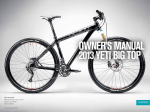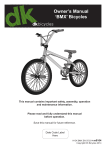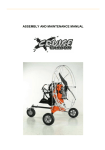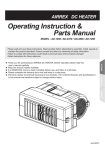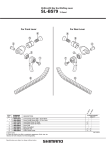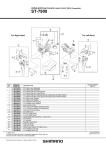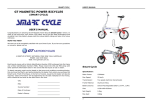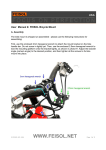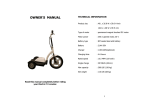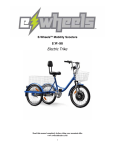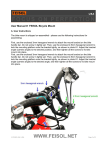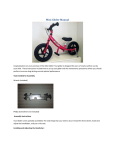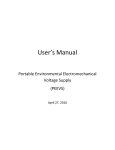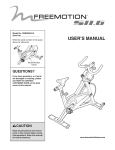Download Manual - Camping World
Transcript
Bicycle Owner's Manual Easy Access Bike AGE: FROM 9 YEARS OLD AND UP IMPORTANT Check bike after assembly or any adjustments. Consult bicycle retailer with questions. Always wear a helmet. Children should never ride after dusk or at night Before use, check that the front wheel is firmly attached and brakes are in proper working condition. Adults should never ride after dusk or at night, unless absolutely necessary. If it is absolutely necessary, you must take steps to make yourself visible. (See Owner's Manual for requirements). On wet roads, apply brakes early and gradually. Bicycle User Manual — Cruiser, Trike, 1-speed and 6-speed models Some of the contents and illustrations in this manual are for models other than yours. Save this manual, it contains important information on use and maintenance. Folding Instruction for Bike STEP 1: Loosen the seat post quick release and push the saddle with seat post down to the lowest position. Then slightly tighten the quick release again. STEP 2: Unlock the quick release of the handlebar stem and fold the handle bar stem downward to the right band side of the bike. STEP 3: Set the kickstand to the ready for riding position (kick it up horizontally). STEP 4: Unlock the quick release of the frame and fold the front part of the frame to left. STEP 5: Fold the right hand pedal by pushing in and folding down (see page 7) The steps are completed. To fold the Tricycle frame follow steps 1 and 4 of above, then turn the Quick Release Lever counter - clockwise to release the handlebar stem. NOTE: When unfolding for use, reverse those steps and ensure that all quick release hinges are secured tightly and that seat height and handlebar position is adequate for rider. Safety Checks Make sure your bicycle/tricycle is in working condition and that all quick releases on the folding hinges are properly tightened. Always wear safety helmet and reflective clothing in the darkness. Check and keep your brakes in proper working order. Have a suitable bell fitted to your bicycle; do not have any other type of warning device. Make sure your tires are in good condition and are properly inflated. Check that the chain is tight and in place. Check that the moving parts are lubricated sufficiently. Inspection and Maintenance For your safety and enjoyment, and to ensure a long life for your folding bike/trike, inspect and maintain your bike/trike regularly. The proper condition and function of the key systems is critically important to your safety. -1- Brake mechanism - inspect before every ride and adjust as needed Tire pressure - inspect before every ride and adjust as indicated Tire wear or damage - inspect before every ride and replace as needed. Brake pad & cable tension - inspect before every ride and adjust or replace as needed. Hub bearings - inspect periodically, clean and lubricate, adjust as needed. Chain lubrication - inspect periodically, clean and lubricate. Reflectors - inspect before every ride, clean and tighten as needed. All moving parts should occasionally be cleaned and lubricated as needed. Brake and Cable Adjustment a.V-Brake for Folding Bike V-Brakes on your bike are fully adjusted when you purchase the bike. They allow you to adequately slow down and stop the bike when the brake lever is squeezed. Periodically checking and adjusting the brakes is strongly recommended. Braking cables can be tightened/loosed by rotating the barrel adjuster nut on the brake levers (clockwise/counter clockwise). The V-brakes have quick release mechanism and allow the brake shoes to clear the tire when a wheel is removed or reinstalled. When the brake quick release is in the open position, the brake will not operate. Make sure you understand the way the brake quick release works on your bike. Consult local bike shop or bicycle technician for detail whenever is needed. Barrel Adjuster V-Brake b.Drum Brake for Folding Trike Drum Brake on your trike is pre-adjusted. However, if the front wheel is not turning freely as a result of a tight drum brake, readjust the cable adjusting screw. Drum Brake -2- WARNING: The shorter the brake lever reaches, the more critical it is to have correctly adjusted brakes, so that full braking power can be applied within available braking travel distance. Insufficient braking travel distance to apply full braking power can result in loss of control. Check that the brake quick release is close and the straddle cable is securely engaged. Squeeze the brake levers. Confirm that the brake shoes are contacting the wheel rim within an inch of brake lever movement. You must be able to apply full braking force at the levers without having them touch the handlebar grips. Otherwise, your brakes need adjustment. Do not ride until the brakes are properly adjusted. Coaster Brake for Folding Trike & Folding Cruiser Coaster hub brake in the rear wheel offers the advantages of reliability and easy operation. The brake is operated by applying back pedal pressure and allows the rider to "coast" without pedaling. Operate the coaster brake as follows: 1.Push the pedals backward to move the chain backward. 2.The chain activates the coaster brake mechanism that is inside the rear wheel hub for braking. Make sure the brake arm is correctly attached to the Chain Stay with the brake arm clip. Otherwise the brake will not work. WARNING: Do not ride the bicycle/tricycle unless the brakes are functioning properly. To test, apply the brakes, while trying to push the bike forward to make sure it will stop the bicycle. Brake maintenance (Coaster Brake) There are many models of coaster hubs available, and the internal mechanisms are very complex. They require infrequent maintenance as far as lubrication, adjustment or replacement of the internal parts; if needed, ask a qualified specialist for help. Keep the coaster hub sprocket clean and oil it along with the chain. Derailleur Gear System Adjustment If your bike is equipped with 6 speed gear system, the gear system consists of: a freewheel, a rear derailleur (which moves the chain up and down the freewheel to change the gear ratio), a gear shifter (on right hand side of handlebar), a control cable and a chain. The purpose of derailleur is to move from one sprocket to another to allow for a variety of gear ratios. These ratios allow the rider to maintain a constant pedal revolution in a variety of road and speed conditions. The derailleur gears on your bike are indexed. Each time you turn the gear shifter one click, the rear derailleur travels a certain distance to engage to next gear. This enables you easier and more accurate gear changing. -3- WARNING: Pedaling backwards while changing gears can jam the chain causing damage to your bike and cause a crash. Your local bike dealer will be able to assist you if you are uncertain about the steps in shifting gears. Derailleur Adjustment: From time to time your derailleur needs adjustment. You may need to tighten the derailleur cable to remove excessive cable slack. Excessive slack in the cable will cause the derailleur to miss shift. Adjustment Steps: Locate the two adjusting screws on the surface of the derailleur. Turn the screws clockwise or counter-clockwise half a turn and test the derailleur changing gear. Continue to turn the screws until the chain is pitching correctly onto each gear. (If you are not sure of these steps, consult your bike dealer or technician.) Adjusting Screws Inter 3 Speed Gear System Adjustment (Trike) 1. Move the indicator cover for easy gear adjustment. 2. Make sure that no more than 2.5mm (1/8”) of axle protrudes from the axle hex nut. 3. Select 2nd gear and turn the pedal crank forward to ensure the gear is engaged. Turn the cable adjuster or cable connector until the end of the indicator rod is level with the end of the axle. 4. Tighten the cable-adjusting locknut and indicator locknut to lock in adjustment. 5. Select 3rd gear position, rotate the pedal crank, change back to 2nd gear and check adjustment. Retry the stages description above when the gear changing is not correct. 6. If there is an indicator cover, fit it firmly onto the guide nut or the guide pulley set. Adjusting Screws -4- WARNING: Riding the gear hub out of the adjustment may cause damage to the internal parts and possible malfunction. Tires and Wheels Adjustment Check tire inflation printed on tires. A visual check can be done by putting one hand on the saddle, and one on the intersection of the stem and handlebars, then bouncing your weight one the bike/trike while looking at tire deflection. Compare what you see with how it looks when you know the tires are correctly inflated. Adjust if necessary. Spin each wheel slowly and look for cuts in the tread and sidewall. Replace damaged tires before riding. Spin each wheel and check for the brake clearance and side-to-side wobble. If a wheel wobbles or hits the brake pads, take it to a qualified bike shop to have the wheel corrected. Handlebar and Stem Adjustment a. Foldable Type. Use Allen wrench to change the angle of the handlebar by loosening its binder bolt, rotating the bar or extension to the desired angle, re-centering it and retightening the binder bolt enough so that the bars or extension can't move in relation to each other and the stem. If the stem is not properly aligned with the front wheel, it will need to be adjusted. Loosen the binder bolt on the stem (unlock the folding hinge and fold the stem before you can loosen the binder bolt). Place the front wheel between your legs and twist the handlebar/stem assembly to align the handlebars in relation to the stem. Then retighten the binder bolt. b. Quick Release Type Turn the Quick Release Lever clockwise to tighten the handlebar stem. Turn the Quick Release Lever counter-clockwise to release the handlebar stem. Warning: Failing to properly tighten the stem binder bolt or the handlebar binder bolt, may compromise steering action, which could cause you to lose control and fall. WARNING: The stem must NOT project from the head tube beyond its -5- minimum insertion or maximum extension marks. WARNING: Do not over tighten the stem bolt or other clamping devices; there is a danger of damaging the stem and the fork and risk of injury to the rider. Saddle Adjustment Correct saddle adjustment is an important factor in getting the best performance and comfort from your bicycle/tricycle. a.Saddle height adjustment Your leg length determines the correct saddle height. To check for correct saddle height: - Sit on the saddle - Place one heel on a pedal - Rotate the crank until the pedal with your heel is on the lowest position and the crank is parallel to the seat tube. Your leg should be almost straight. If not, your saddle height needs adjustment. To adjust the saddle height, loosen the seat post quick release and move the seat post up or down as required. Retighten the seat post by locking the seat post with quick release. Make sure that it is tightened enough and you cannot twist the saddle easily out of alignment. WARNING: The seat post must NOT project from the frame beyond its minimum insertion or maximum extension marks. b.Saddle front/back adjustment To find the most comfortable position, loosen the saddle clamp and adjust the saddle forward or back to suit you (this applies to some saddle models only). WARNING: After any saddle adjustment, be sure to tighten the saddle adjusting mechanism properly before riding. Height Requirement is Determined by the Rider's Leg Length Stand over height is the basic element of bike/trike fit. Rider must be able to straddle bicycle/tricycle with at least 25mm (or 1") clearance above the horizontal bar when standing. A bicycle/tricycle that is too big or too small for the rider is hard to control and can be uncomfortable. If your bicycle does not fit Not Less properly you may lose control and fall. Than 1” -6- Tools Needed Your bike/trike is fully assembled. However, some tools are essential when performing self-maintenance: I. Adjustable Wrench 2.Flat-head Screwdriver 3.Phillips Screwdriver 4.Slip-Joint Pliers 5.Metric Allen Wrenches Foldable Pedal If your bike/trike has foldable pedals, Following are the steps to fold: Push the pedal inward to the crank. Then fold it downward. To unfold: Lift the pedal perpendicular to the crank. 1. Push inward 2. Fold downward Carrier (Folding Bike and Folding Cruiser Bike) Your bike is equipped with a removable carrier. WARNING: Maximum load rapacity of this carrier is 11 lbs. Da not overload or carry any passenger on the carrier. Basket (Trike only) Your trike is equipped with a removable rear basket. WARNING: Maximum load capacity of this basket is 22 lbs. Do not overload or carry any passenger on this basket. Reflectors Reflectors are important safety devices that are designed as an integral part of your bicycle/tricycle. Do not remove them on any circumstance. Keep clean and replace them immediately if damage is found. -7- Basic Safety Rules Always perform the mechanical check explained in this manual before every ride. Always wear a helmet and safety gear that complies with local laws. Keep body and clothing away from the chain ring and other moving parts on the bike/trike. Wear shoes that fit, will stay on your feet and properly grip the pedals. Never ride with unprotected or poorly protected feet. Do not ride wearing sandals or other open footwear. Wear bright, visible clothing (reflective in darkness) that does not restrict movement but is not so loose that can be caught by the moving parts of the bike or objects as you ride past them. Do not jump or attempt stunts on the Bicycle/Tricycle. Travel at or below the speed where you can comfortably react to any problem that could occur during your ride. Allow for ample time to brake slowly and safely to avoid obstacles. Riding on the Road Before you move off from the side of the road, think which way you intend to go and look both ahead and behind for moving traffic. If there is traffic approaching, wait until it has passed. Except in an emergency, stopping must be done carefully and gradually. Think of where you wish to stop and look particularly to the rear over your right shoulder for following traffic. Signal that you are going to slow down and stop. When braking keep both hands on the handlebar. On a wet road, it will take a much longer distance to stop; so allow at least twice the distance than normal. You must keep at least one hand on the handlebar at all time. Always keep both feet on the pedals. Always use a bicycle way or cycle lane. Never tow or hold on to a vehicle or tow another cyclist or other vehicle. You must not carry a passenger. You must not carry anything which might affect your complete control of your bicycle or your balance, or can be caught into the wheels or chain. You must not carry anything that blocks, or may block, your view of the road. Do not wear earphones of any audio devices. Do not lead an animal. -8- Night Riding Safety Make sure your bicycle/tricycle is equipped with correctly positioned reflectors, and an adequate headlight and taillight. Wear bright, reflective clothing. Make sure your clothing or objects are not obstructing your bike/trike reflectors or installed lights. Ride slowly and on routes that are already familiar to you. WARNING: Reflectors are not a substitute for required lights. Riding at dawn, at dark, at night or at other times of poor visibility without an adequate bicycle lighting system is dangerous and may result in serious injury. Wet Weather Riding Under wet conditions, the stopping power of your brake (as well as the brakes of other vehicles sharing the road) is dramatically reduced and your tires do not grip nearly as well. This makes it harder to control speed and easier to lose control. To make sure that you can slow down and stop safely in wet conditions, ride more slowly and apply your brakes earlier and more gradually than you would under normal, dry conditions. WARNING: Wet weather impairs traction, visibility and braking for the rider and for other vehicles sharing the road. The risk of accident is dramatically increased in wet conditions. Additional Warnings: Use only neutral non alkali/acid based detergent to clean chain and re-lubricate all derailleur parts regularly. For any questions regarding adjustments, maintenance or operation, contact a professional bicycle dealer. LIMITED WARRANTY POLICY Camping World, Inc. offers a lifetime warranty against manufacturer's defects on all frames and forks (except suspension fork). We also warranty any components which prove defective for a period of 90 days from date of consumer purchase. This warranty does not cover any damage caused by abuse, accident or improper assembly. If you find any missing or defective parts contact www.CampingWorld.com -9- 1










